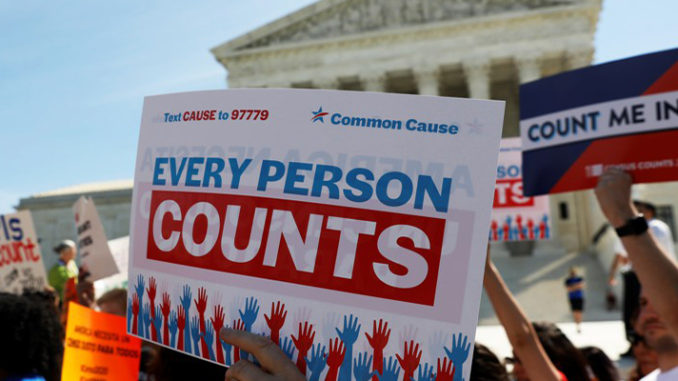
by David G. Savage
The Supreme Court is set to rule this month on two issues that could shape political power in the decade ahead — and also shape perceptions of Chief Justice John G. Roberts Jr. and the court he leads.
With the court’s term coming down to its final weeks, the justices are due to decide on the constitutionality of partisan gerrymandering, a practice that allows party leaders to draw maps for election districts that ensure their candidates will win most of their races. And they will rule on the Trump administration’s plan to ask all households about the citizenship status of family members as part of the 2020 census.
The pair of political disputes puts the chief justice in an awkward spot.
“To put it bluntly, both of these cases have major implications for the future of the Republican party,” said Elizabeth B. Wydra, president of the Constitutional Accountability Center, a self-described progressive group. “If Roberts truly cares about the public perceiving him and his colleagues as something other than politicians in robes, he should be very worried by the potential impact to the legitimacy and public standing of the court.”
Thanks to President Trump’s election and Republican control of the Senate, Roberts leads a court with five Republican appointees who can outvote the four Democratic appointees. He is also a conservative who played a lead role in striking down limits on campaign spending and a key part of the Voting Rights Act’s special protections for minority voters throughout the South.
But Roberts also has sought to distance the court from what he calls the “partisan rancor” in Washington.
“We don’t work as Democrats or Republicans,” he has publicly said. When President Trump derided an “Obama judge” in November, Roberts issued a rare statement to rebuke the president. “We do not have Obama judges or Trump judges, Bush judges or Clinton judges,” he said.
The chief justice also has made clear that he would like to avoid 5-4 rulings in the biggest cases, like the dispute over partisan gerrymandering. To avoid that split in the gerrymandering case, he probably would need to enlist Justices Elena Kagan and Stephen G. Breyer, both Democratic appointees, in a compromise ruling that left open future legal challenges to overly partisan election maps.
Gerrymandering was hardly a Republican invention. Democrats in California and Illinois were among the pioneers in drawing election maps to lock in majorities for their candidates.
But in the 2010 midterm election, the GOP won full control in states including North Carolina, Pennsylvania, Ohio, Michigan and Wisconsin, and Republicans drew election maps that ensured their party would typically win a lopsided majority of the seats. Those gerrymanders helped the Republicans protect their majority in the House of Representatives until the Democratic wave in 2018 and kept them in control of all five of the state legislatures even though Democrats won more votes in those states.
Citing the partisan tilt, judges recently have struck down the district maps in each of those states on the grounds that Democratic voters were denied the right to a fair and equal vote.
The Supreme Court, however, has never struck down a partisan gerrymander. The justices sounded closely split in March when they heard an appeal from North Carolina’s Republican leaders, who freely admitted they drew the districts for a “partisan advantage,” aiming to ensure Republicans would win 10 of the state’s 13 congressional seats.
The census dispute also has become intensely partisan. Citing the climate of fear in immigrant communities, demographers and political scientists testified in lower-court proceedings that millions of people would refuse to answer if the census includes a citizenship question. That would lead to a significant under-count of the population in states like California that have large immigrant populations — areas that also typically tilt in favor of Democrats. Federal judges in New York, San Francisco and Baltimore blocked the added question.
Last week, lawyers who sued over the census plan raised a second concern. They said a 2020 census with detailed data on citizens would permit states to divide their election districts based on the number of eligible voters, not the total population. This “would be advantageous to Republicans and non-Hispanic whites” and “would clearly be a disadvantage for Democrats,” Republican strategist Tom Hofeller wrote in 2015.
An adviser to Commerce Secretary Wilbur Ross had consulted with Hofeller, who died in 2018, before Ross decided to add the question to the census. The Census Bureau falls under Ross’ jurisdiction.
When the court heard arguments in April, the five conservatives sounded as though they were ready to rule for Ross.
“It’s hard to overstate the significance of the census and partisan gerrymandering cases,” said Leah Litman, a law professor at UC Irvine and a former Supreme Court clerk.
“Upholding the addition of the citizenship question and forgoing any judicial oversight of partisan gerrymandering would allow Republican minorities to entrench their political power for decades,” Litman said. “They will make our ‘representative’ branches less representative and our democracy less democratic.”
In addition to those cases, the court has more than 20 others due be decided by the end of June. Here are several:
Cross on public land: Does a nearly century-old, 40-foot cross standing at a busy Maryland intersection violate the 1st Amendment’s ban on “an establishment of religion,” or it can be remain as a memorial to local soldiers who died in World War I? (American Legion vs. American Humanist Assn.)
Double jeopardy: Can both the state of Alabama and federal prosecutors try and convict a man for the same crime of being a felon in possession of a gun? The 5th Amendment says Americans may not be “twice put in jeopardy of life or limb … for the same offence,” but in the past the Supreme Court has said a state and the federal government are “separate sovereigns” who are free to enforce their own laws, even if they overlap. (Gamble vs. United States)
Scandalous trademarks: Did the U.S. Patent and Trademark Office properly refuse to register the trademark of Los Angeles entrepreneur Erik Brunetti and his FUCT brand of clothing because it was “scandalous” or “immoral” under federal law, or does this part of the law violate the 1st Amendment’s protection for free speech? (Iancu vs. Brunetti)
Property rights: Can a land owner go directly to federal court if she thinks a local ordinance has the effect of taking her property, or must she first seek compensation from a state judge? The California-based Pacific Legal Foundation is asking the high court to overturn a 1985 ruling that has required land owners to go to state court first. Their client is a Pennsylvania woman who objected to people crossing her property to visit a family burial plot. (Knick vs. Scott Township)
Race and juries: Did a white prosecutor from Mississippi engage in racial discrimination when he excluded all but one black person from the jury for the sixth murder trial of a black defendant? The case of Curtis Flowers drew national attention because he has been tried six times for the murder of four people in a furniture store where he briefly worked. (Flowers vs. Mississippi)
Partisan gerrymanders: Did North Carolina’s Republican legislature violate the rights of voters when it drew a statewide map to elect Republicans in 10 of 13 districts? (Rucho vs. Common Cause) Did Maryland’s Democrats violate the rights of Republican voters when they shifted tens of thousands of voters to oust a veteran Republican from one seat and elect a Democrat? (Lamone vs. Benisek)
Census and citizenship: Did Commerce secretary Wilbur Ross have a legitimate reason for adding a citizenship question to all census forms for the first time since 1950? (Department of Commerce vs. New York)
David G. Savage covered the Supreme Court and legal issues for the Los Angeles Times in the Washington bureau since 1986. He has covered the Senate confirmation hearings for all of the current justices. In addition to writing about the court’s work, he has written on the legal battles that have raged in Washington. He joined The Times in 1981 and was an education writer on the Metro staff for five years. He has degrees from the University of North Carolina at Chapel Hill and Northwestern University.



